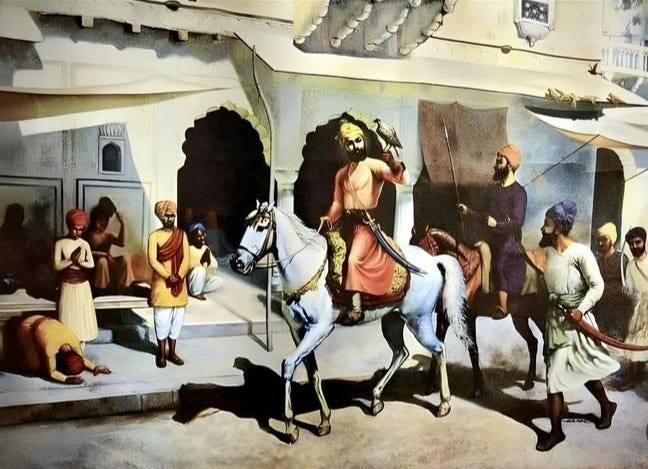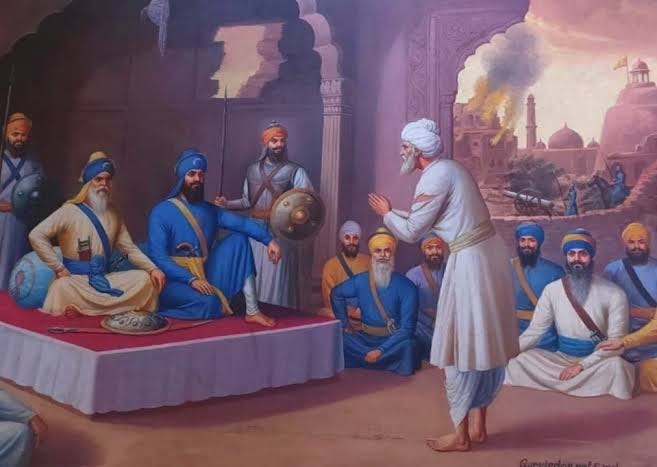Onset:
Diwali has recently passed, and the boomers with their caustic arguments over whether or not it is a Sikh festival have quieted down until the next controversy. Although Sikhi is considered the world’s youngest faith, the unnecessary hair-splitting which the current crop of white-bearded Sikh imbeciles indulge in render even its most simplest elements susceptible to endless debate. Other than publicly humiliating them and ostracizing them from Gurudwaras, there is no other comprehensive avenue available to the youth if they desire to reclaim the heroic legacy of their legendary empire-building forefathers. Until such a period, the Sikh youth must build up their strength by studying the past and immersing themselves in Gurmat (the Sikh theology) as a means of preparing themselves for the future.
The Historicity Of Diwali:
The Sikh literary tradition abounds with a rich tapestry of figurative metaphors extolling Sikh moralism and virtuosity by drawing upon multiple Indic concepts including festivals. The foremost Sikh theologian Bhai Gurdas (c.1551-c.1636) elaborates,
ਦੀਵਾਲੀ ਦੀ ਰਾਤਿ ਦੀਵੇ ਬਾਲੀਅਨਿ।
On the night of Diwali, lamps are lit.
ਤਾਰੇ ਜਾਤਿ ਸਨਾਤਿ ਅੰਬਰਿ ਭਾਲੀਅਨਿ।
In a night sky, the stars glimmer and vanish.
ਫੁਲਾਂ ਦੀ ਬਾਗਾਤਿ ਚੁਣਿ ਚੁਣਿ ਚਾਲੀਅਨਿ।
In a pleasure garden, multiple flowers are observed growing.
ਤੀਰਥਿ ਜਾਤੀ ਜਾਤਿ ਨੈਣ ਨਿਹਾਲੀਅਨਿ।
Multiple hordes are witnessed thronging to pilgrimage sites.
ਹਰਿਚੰਦਉਰੀ ਝਾਤਿ ਵਸਾਇ ਉਚਾਲੀਅਨਿ।
Thousands of such mirages are daily seen appearing and then vanishing.
ਗੁਰਮੁਖਿ ਸੁਖ ਫਲ ਦਾਤਿ ਸਬਦਿ ਸਮ੍ਹਾਲੀਅਨਿ ॥੬॥
But the enlightened Sikh is one who reaps the ever-present fruit with the aid of the Guru’s injunctions.
-6:21
Diwali is mentioned as a mirage, a transitionary festival that once celebrated does not daily transpire while an enlightened Sikh enjoys more permanent pleasures within themselves. Nonetheless, this is not some logical dismissal of the festival as the boomer-brigade is often wont to do on the grounds of rationalism. On the other hand, they are equally mum when it comes to the plethora of contemporary manuscripts that abound in the Gurus’ and later Khalsa Jathedars and Sirdars hand enjoining the Sikhs to congregate in their presence at Diwali. We then have the thunderous hair-splitting over Bandi-Chod or the great liberation when the sixth Guru exited the Gwalior prison with 52 prisoners in tow. Did it coincide with Diwali or did it not? Chairs continue to defy gravity in Gurudwaras over this issue.
Mani Singh:
A more precise answer to what significance, if any, Diwali holds in the Sikh praxis can be discerned from the martyrdom of the esteemed eighteenth-century Sikh theologian and warrior Bhai Mani Singh (c.1644-c.1738). Of low-caste origin, Mani Singh’s family were converts to Sikhi and were trained as erudite intellectuals under the tutelage of the Sikh Gurus culminating in Mani Singh himself being awarded a chief position under the tenth Sikh Guru, Guru Gobind Singh. Initially a warrior, Mani Singh was deemed too important by the Guru and his advisory Khalsa council to be dispatched on the battlefield and relegated to a behind-the-scenes role.
Mani Singh was well aware that the traditional approach to Diwali held no meaning for Sikhs. In fact, Guru Nanak-the progenitor Sikh Guru-had already dismissed the festival’s chief deity Ram Chandra as nothing but a foolish devil in his chief compositions faithfully recited by his Sikhs.
ਰਾਮੁ ਝੁਰੈ ਦਲ ਮੇਲਵੈ ਅੰਤਰਿ ਬਲੁ ਅਧਿਕਾਰ ॥
ਬੰਤਰ ਕੀ ਸੈਨਾ ਸੇਵੀਐ ਮਨਿ ਤਨਿ ਜੁਝੁ ਅਪਾਰੁ ॥
ਸੀਤਾ ਲੈ ਗਇਆ ਦਹਸਿਰੋ ਲਛਮਣੁ ਮੂਓ ਸਰਾਪਿ ॥
ਨਾਨਕ ਕਰਤਾ ਕਰਣਹਾਰੁ ਕਰਿ ਵੇਖੈ ਥਾਪਿ ਉਥਾਪਿ ॥੨੫॥
ਮਨ ਮਹਿ ਝੂਰੈ ਰਾਮਚੰਦੁ ਸੀਤਾ ਲਛਮਣ ਜੋਗੁ ॥
ਹਣਵੰਤਰੁ ਆਰਾਧਿਆ ਆਇਆ ਕਰਿ ਸੰਜੋਗੁ ॥
ਭੂਲਾ ਦੈਤੁ ਨ ਸਮਝਈ ਤਿਨਿ ਪ੍ਰਭ ਕੀਏ ਕਾਮ ॥
ਨਾਨਕ ਵੇਪਰਵਾਹੁ ਸੋ ਕਿਰਤੁ ਨ ਮਿਟਈ ਰਾਮ ॥੨੬॥
“Profusely aggrieved, Ram (Chandra) prepares his army for war internally strengthening his resolve. The army of apes serves him, preparing both mentally and physically for conflict. His wife Sita has been abducted by the ten-headed fiend while his brother Lakshman is cursed to die. Nanak, the true Creator meanwhile creates and creates creating and destroying as he sees fit. Within his mind, Ram Chandra is apprehensive worrying about what is transpiring with Sita and Lakshman. He remembers Hanuman who comes running to meet him. The foolish devil (Ram Chandra) fails to realize how his Maker works. Nanak is not anxious for what his Ram does his Ram never effaces.”
-Guru Granth, 1412.
Nonetheless, the universality of the festival was such that even the Islamic fanatics such as the Mughals embedded it within their calendars and declared it an official holiday to alleviate their own political stress and keep the masses under some modicum of control. Resultantly, it became the marker of a new year for many and the festivities and were often utilized by the Sikhs to visit the Gurus and/or hold mass congregations to initiate converts into the faith and plan for the future. This became even more pronounced in the post-Guru era where after the fall of Banda Singh and the first Khalsa state, the Sikh government had to be redesigned in a hexalogical structure to ensure the faith’s survival.
Alongside the astute commander, and master of realpolitik, Nawab Kapur Singh Mani Singh collaborated with several other prominent Sikh leaders to rework a time-based Sikh calendar of important dates. Such an identification of necessary periods proved a boon for the minority Sikhs who, if everything else failing, would be able to collate together on certain dates to at least alleviate their ongoing challenges and seek support from each other. The hexalogical Sikh government also had to be seen in action for its constituents to continue placing faith in it. For this reason it was decided that its operations would constitute:
-First tier: Gurudwaras and local congregations aided by those who submitted to the Khalsa and renounced their false faiths.
-Second tier: Khalsa representatives of the first tier reporting all important matters to a higher authority that in time came to be known as Misldar.
-Third tier: Khalsa commanders administering large portions.
-Fourth tier: A foremost commander controlling the third tier.
-Fifth tier: A semi-monarchial first among equals presidential Khalsa generalissimo.
-Sixth tier: A council of five Khalsa Sikhs acting as a due constraint on the generalissimo’s power and ensuring the upkeep of the faith in all arenas.
Mani Singh deemed it prudent if annual assemblies could be held uniting both the democratic (first and second tiers), aristocratic (third and fourth tiers), and monarchial (fifth and sixth tiers) of the Khalsa state in a decision-making exercise twice a year. It was agreed by all involved that two occasions would provide for such events if all transpired well and the Sikhs were not battling for survival: Vaisaakhi or the harvest festival that also marked the ratification of Guru Nanak’s Khalsa by Guru Gobind Singh, and Diwali that was more or less the dawn of the Indic new year and would herald cessation of military activity by anti-Sikhs. More coincidentally, both events were marked by a six-month gap between them.
It was for this very reason that the Sanataani zealot Lakhpat Rai decided to execute Mani Singh on Diwali. During a seeming ceasefire between the Khalsa and the Hindu-Mughal combine, Mani Singh informed the Islamic authorities that the Sikhs would congregate at Amritsar for Diwali. He was informed that the Islamic state expected taxation from the Sikhs. Rai, however, positioned himself to attack the Sikhs thereon and Mani Singh sensing the Muslim treachery cautioned the Sikhs to avoid Amritsar. Detained for not being able to pay the tax, he refused to convert to Islam and was subsequently dismembered happily laughing at his executioner’s discomfort in his last moments.
Ratan Singh Bhangu:
The nineteenth-century Sikh chronicler Ratan Singh Bhangu provides a similar narrative of Diwali, not as some celebratory religious festival but rather as an assembling time for the Sikhs whereon the Sarbat Khalsa or the Khalsa’s state assembly-uniting all six of its political organs- was held. In his Sri Gur Panth Prakash chronicle he delineates in stirring terms how the mighty Singhs of old observed Diwali:
“Ransacking the nations around them, they congregated at Amritsar and made it their chief headquarters. On Vaisaakhi and Diwali they held large congregations. At the Harmandar they listened to and discussed how to live the Guru’s injunctions. At the Akal Bunga, they ascended the Takhat and planned on killing non-Sikhs opposed to their existence and snatching their sovereignties. This was the glorious court of the Sarbat Khalsa…”
-Sri Gur Panth Prakash, vol. ii.
Among other things, Bhangu’s emphasis on discussing how to live the Guru’s injunctions should not be overlooked as some expression of religiosity or an exercise in filling his word quota. It was this cornerstone of the traditional Sikh praxis that differentiates it from the dual stupidity of either reciting Gurbani as a mantra or just comprehending it for comprehension’s sake and not imbibing. The essence of the Sikh variation of Diwali, historically, was not one of celebrating the vagaries of lustful Sanataan deities but rather congregating to focus on the Guru’s injunctions and then implementing them religiopolitically and sociopolitically for the sake of the Khalsa state.
ਜਹ ਕਰਣੀ ਤਹ ਪੂਰੀ ਮਤਿ ॥ ਕਰਣੀ ਬਾਝਹੁ ਘਟੇ ਘਟਿ ॥੩॥
“Where the acts performed are noble, then the intellect has been fully developed on the Guru’s advise. But without acts, the intellect erodes away.”
-Guru Granth, 25.
Bhangu’s salient description of discussions based on the injunctions recited from the Guru Granth in the Harmandar are what is lacking in Sikh practicality today. Avaricious and corrupt whitebeards have banned them fearing that such contemplative immersion in the Guru’s injunctions will surely inspire a new generation of strong willed Sikhs to arise and challenge their iron-fisted control over Gurudwaras for nothing more than filling their own seemingly bottomless pockets. Had Bhangu been alive today, he would have surely exhorted the youth to plan for and deliver their deaths.
ਕਥਾ ਪੁਰਾਤਨ ਇਉ ਸੁਣੀ ਭਗਤਨ ਕੀ ਬਾਨੀ ॥
ਸਗਲ ਦੁਸਟ ਖੰਡ ਖੰਡ ਕੀਏ ਜਨ ਲੀਏ ਮਾਨੀ ॥੩॥
“I have heard the same ancient discourse from all the teachings of the (divine) adherents. All foes have been shredded to bits for which your followers are honored.”
-Guru Granth, 815.

Conclusion:
By indulging in hate-filled debates specifically engineered to push the youth away from Gurudwaras and/or identify the most dedicated and slate them for a premature demise, the boomer-brigade has successfully erased Sikhi’s unique political distinction and submerged it in vacuous enlightenment era secularistic feel-good thought that deviates from the Gurus’ noble aims. In the ceaseless debate over Diwali, these whitebeards pathetically wring their hands over the lighting of lamps but are mum when it comes to holding political assemblies and addressing the need for Sarbat Khalsas. Try as they might, history cannot be rewritten but their generation will accrue infamy for its devious role in undermining the Gurus’ philosophy.





